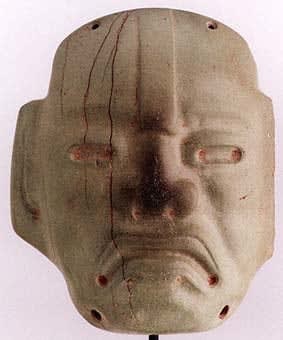Olmec Stone Pectoral/Pendant of a Mask, 1000 BCE - 600 CE
Stone
3.125 x 3.75
PF.3470
The Olmecs are generally considered to be the ultimate ancestor of all subsequent Mesoamerican civilisations. Thriving between about 1200 and 400 BC, their base was the tropical lowlands of south...
The Olmecs are generally considered to be the ultimate ancestor of all subsequent Mesoamerican civilisations. Thriving between about 1200 and 400 BC, their base was the tropical lowlands of south central Mexico, an area characterized by swamps punctuated by low hill ridges and volcanoes. Here the Olmecs practiced advanced farming techniques and constructed many permanent settlements. Their influence, both cultural and political, extended far beyond their boundaries; the exotic nature of Olmec designs became synonymous with elite status in other (predominantly highland) groups, with evidence for exchange of artefacts in both directions. Other than their art (see below), they are credited with the foundations of writing systems (the loosely defined Epi-Olmec period, c. 500 BC), the first use of the zero – so instrumental in the Maya long count vigesimal calendrical system – and they also appear to have been the originators of the famous Mesoamerican ballgame so prevalent among later cultures in the region. The art form for which the Olmecs are best known, the monumental stone heads weighing up to forty tons, are generally believed to depict kingly leaders or possibly ancestors. Other symbols abound in their stylistic repertoire, including several presumably religious symbols such as the feathered serpent and the rain spirit, which persisted in subsequent and related cultures until the middle ages.
Comparatively little is known of their magico-religious world, although the clues that we have are tantalising. Technically, these include all non- secular items, of which there is a fascinating array. The best- known forms are jade and ceramic figures and celts that depict men, animals and fantastical beasts with both anthropomorphic and zoomorphic characteristics. Their size and general appearance suggests that they were domestically- or institutionally-based totems or divinities. The quality of production is astonishing, particularly if one considers the technology available, the early date of the pieces, and the dearth of earlier works upon which the Olmec sculptors could draw. Some pieces are highly stylised, while others demonstrate striking naturalism with deliberate expressionist interpretation of some facial features (notably up-turned mouths and slit eyes) that can be clearly seen in the current mask.
This beautiful Olmec stone pendant/pectoral is carved delicately and polished to achieve a serene grace. The delicate carvings form the most gentle and sophisticated facial features, which also cast soft, almost mystical shadows. The slight indentations indicate the eyebrows, cheeks and the chin. The large mouth and the nose are perfectly aligned with the vertical sculptural form on the forehead that create a symmetry. Such magnificent sculpture manifests a fascinating Olmec legend. The sculpture features large, fleshy lips of which the upper part is curled upward, like that of a feline. This unusual facial feature is a sign of an Olmec legend about the jaguar baby. Babies born with this feline, jaguar, features were considered as possessing powers of a god and, thus, were treated in special ways. It is no surprise that people of Olmec culture so lovingly carved this beautiful sculpture with jaguar's attributes. Such a fascinating tale and the strong, mesmerizing artistic qualities of the stone pendant/pectoral seem to grab and demand our attention even today.
Comparatively little is known of their magico-religious world, although the clues that we have are tantalising. Technically, these include all non- secular items, of which there is a fascinating array. The best- known forms are jade and ceramic figures and celts that depict men, animals and fantastical beasts with both anthropomorphic and zoomorphic characteristics. Their size and general appearance suggests that they were domestically- or institutionally-based totems or divinities. The quality of production is astonishing, particularly if one considers the technology available, the early date of the pieces, and the dearth of earlier works upon which the Olmec sculptors could draw. Some pieces are highly stylised, while others demonstrate striking naturalism with deliberate expressionist interpretation of some facial features (notably up-turned mouths and slit eyes) that can be clearly seen in the current mask.
This beautiful Olmec stone pendant/pectoral is carved delicately and polished to achieve a serene grace. The delicate carvings form the most gentle and sophisticated facial features, which also cast soft, almost mystical shadows. The slight indentations indicate the eyebrows, cheeks and the chin. The large mouth and the nose are perfectly aligned with the vertical sculptural form on the forehead that create a symmetry. Such magnificent sculpture manifests a fascinating Olmec legend. The sculpture features large, fleshy lips of which the upper part is curled upward, like that of a feline. This unusual facial feature is a sign of an Olmec legend about the jaguar baby. Babies born with this feline, jaguar, features were considered as possessing powers of a god and, thus, were treated in special ways. It is no surprise that people of Olmec culture so lovingly carved this beautiful sculpture with jaguar's attributes. Such a fascinating tale and the strong, mesmerizing artistic qualities of the stone pendant/pectoral seem to grab and demand our attention even today.
53
of
53



